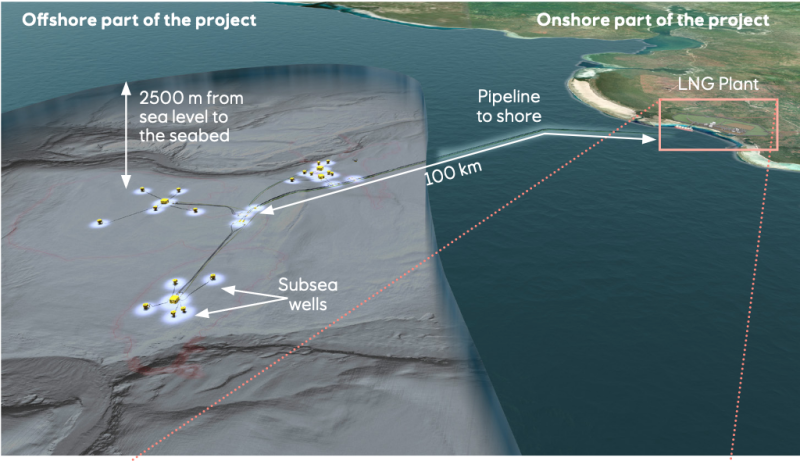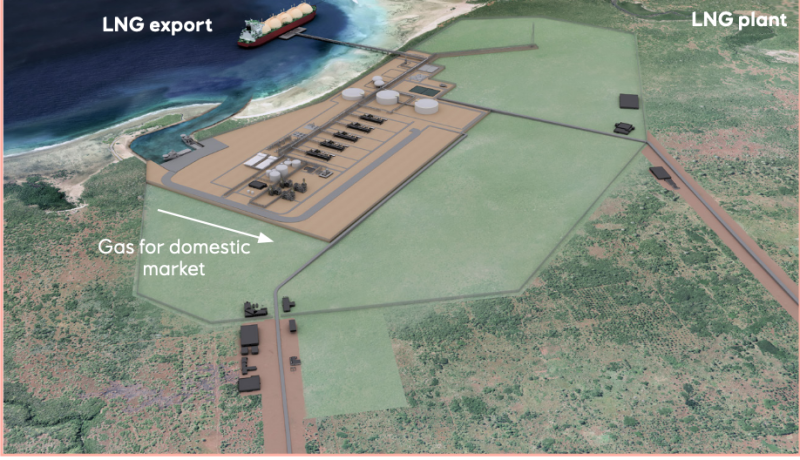The government of Tanzania has signed a liquefied natural gas (LNG) framework agreement with the UK’s Shell and Norway’s Equinor that is expected to kick-start construction of a $30- to $40-billion LNG export terminal to commercialize the country’s deepwater offshore gas reserves.
The deal signed by the three parties on 11 June is foundational to the Tanzanian government’s issuance of a Host Government Agreement (HGA) later this year which will outline the project’s technical, commercial, and legal terms, according to Bloomberg.
Front-end engineering and design (FEED and pre-FEED) will be completed within 3 years of HGA signing, with a final investment decision targeted in 2025. A 4- to 5-year construction period will follow with a first LNG drop planned by 2029–2030.
The plant will be built at the East African nation’s southern coastal town of Lindi. It will be linked via a 100-km subsea pipeline to significant deepwater gas discoveries off Tanzania’s southern coast and have a 30-year life span, according to Equinor.
If all goes as planned, 2025 will be significant also as the year Tanzania becomes a transit state for crude oil passing from Uganda’s Lake Albert development through the East African Crude Oil Pipeline to be exported through the Tanzanian port town of Tanga.


An artist’s rendering of Tanzania’s future LNG export and gas processing facility at the town of Linde and the deepwater upstream operation offshore that will provide the gas resource. Source: Equinor
Regulatory delays had stalled construction of the LNG project during Tanzania’s late President John Magufuli’s tenure in office, but his successor and current president, Samia Suluhu Hassan, reignited discussions shortly after taking office a year ago, Aljazeera reported. First talks regarding the plant were initiated in 2014. But now there is a new sense of urgency.
Tanzania is among the gas-rich African nations that now see LNG exports as a way to transform their economies in light of today’s geopolitical realignment of energy trade and the opening of new market opportunities. Energy Minister January Makamba singled out Asia as Tanzania’s No. 1 target market given his country’s geographic position on the Indian Ocean, during the LNG signing ceremony.
Developing New Gas Resources
With regard to the development of Tanzania’s gas resource base, Shell currently operates Block 1 and Block 4 offshore where it has discovered 16 Tcf (453 Bcm) of recoverable natural gas. Shell holds a 60% interest in a production-sharing agreement (PSA) with the Tanzanian government that expires in 2024. Other partners include Pavilion Energy (20%) and Jakarta-based Medco Energy (20%).
Pavilion is a subsidiary of Temasek, a global investment company based in Singapore that is focused on LNG shipping and trade in Asia and Europe. Medco has exploration and production operations in Indonesia, Mexico, Libya, and Tanzania as well as interests in power, gas trading and mining, according to the companies’ websites.
Equinor operates Block 2, where it has drilled more than 15 exploration wells since 2011 resulting in nine discoveries at water depths of 2500 m with an estimated 20 Tcf of gas, according to Equinor’s website. The Norwegian major plans to develop the field using subsea wells located on the seabed to avoid having to build expensive facilities at sea level.
Equinor entered the Tanzania market in 2007 after having signed a PSA for Block 2 with Tanzania Petroleum Development Corp. (TPDC). Equinor has a 65% operating interest in Block 2, while ExxonMobil holds a 35% working interest. TPDC has the right under the PSA to participate with a 10% interest.
Overall, Tanzania estimates its recoverable offshore reserves at more than 57 Tcf (1,630 Bcm) which are reported to be the sixth-largest in Africa.
Hassan as well as leaders of other gas-rich African countries have been floating the idea that the continent has the resources to join other global LNG producers in supplying Europe as the EU seeks to end its energy dependence on Russia.
But, as several leaders among those representing the 11 nations present at the Gas Exporting Countries Forum held in Qatar on 22 February (2 days before Russian troops crossed into Ukraine) pointed out, significant investment would be needed to develop new gas infrastructure capable of replacing current Russian imports. Also, Europe would need to sign long-term contracts, Aljazeera noted in its coverage of the forum.
Europe for the most part has moved away from long-term agreements over the past decade, preferring the flexibility of spot market purchases of fossil fuel, especially considering the push to replace carbon-intensive oil and gas with green, low- or no-carbon renewables.
There is also political risk. While Tanzania may be stable, it had planned to join with neighboring Mozambique in a wider vision to create a greater East African LNG hub. But it is uncertain when Mozambique’s stalled LNG development might get back on track after an insurgency caused France’s TotalEnergies to declare force majeure on its multibillion dollar operation in April, 2021.

Equinor’s deepwater offshore blocks that would contribute to the resource base for the Lindi LNG plant. Source: Equinor


